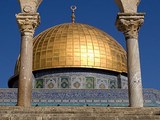 |
 |
Israël 1 : Jerusalem and the story of Humanity
From West to East, the four divisions of the city of Jerusalem stand
side by side, Christian, Armenian, Jewish, Muslim. Because it brings
together Israeli, Christian and Muslim religious traditions, the town,
which can be seen in its entirety from the top of the Mount of Olives,
is awash with famous monuments, all very close to one another. The dome
of the Rock in the Omar Mosque, built in the 7th century is the oldest
Muslim monument in the town.
|


